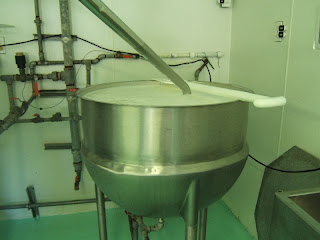After milking, so here we are come to the interesting part of the case: making cheese. mhhhhhh
You should know, for anyone who after reading my comments are to be taken near the first plane to Canada, the cheese here there is not much. And may be even a chauvinist, he is not very good ... Another caveat for true cheese lovers who eat the same morning here, the cheese from raw milk, because it is not forbidden by law! raaaaaaa!! So all the cheeses are pasteurized milk (Well except in Quebec ... they are the Quebecers!).
At the supermarket, the most difficult choice will be to choose between a very young or cheddar, yellow or red, see the same mixed. That being said there are some who are tastier ...
You should know, for anyone who after reading my comments are to be taken near the first plane to Canada, the cheese here there is not much. And may be even a chauvinist, he is not very good ... Another caveat for true cheese lovers who eat the same morning here, the cheese from raw milk, because it is not forbidden by law! raaaaaaa!! So all the cheeses are pasteurized milk (Well except in Quebec ... they are the Quebecers!).
At the supermarket, the most difficult choice will be to choose between a very young or cheddar, yellow or red, see the same mixed. That being said there are some who are tastier ...
In this farm, so it is full of opulence as different cheeses, chic!
It produces blue (much like Roquefort), Gouda (which resembles the old county) buckshot (which looks like the log of goat cheese), feta (which resembles feta), and other niceties ...
Everything is completely organic, and therefore very expensive (I think). The buckshot (the size of the log) are priced at $ 8.75 (knowing that the minimum wage is less than $ 900 !!!), blue is $ 5 per 100g and the rest too. In short, must have the means to eat organic.
Monday here I parachuted into the factory to lend a hand to Jason (the eldest son of the family), so it's the battery unit and hand out notebook and get a little tour of the factory.
Fabrication of the feta
Milk, once out of the goat, is pasteurized at 150 ° F (I do not know how much it is in ° C, rraaaa) for 1h30 in the large tank on the left. After that, it is cooled to 98 ° F and transferred within two square tanks.

Milk, once out of the goat, is pasteurized at 150 ° F (I do not know how much it is in ° C, rraaaa) for 1h30 in the large tank on the left. After that, it is cooled to 98 ° F and transferred within two square tanks.

Then added a coagulant (brown liquid), this one is based on a fungus (it's for vegetarians!) And bacteria Special feta (I do not know the name but it's special feta). Was allowed to stand for 1 hour.


After that, we spent a knife (or several slides here) in milk has coagulated and is still waiting for 1h.


was filtered whey (being careful to keep) ...
We cut squares that are placed in an airtight container with slightly salty whey. The whole was left to macerate for a week.
The departure is the same, namely pasteurized milk. Only then, we must lower the temperature to 88 ° F.
coagulant is added and the bacteria: Penicillium candidum
is increased milk temperature to 98 ° F and allowed to cook 1:30. After that we made cuts and left another 30 min.


is allowed to drain overnight, then returned a second time and it still leaves a whole day. Here, the cheeses are made on Monday. We return on Tuesday, Wednesday, and it is unmolded still leaves a bit dry, on Friday, the cheeses are placed in salt water (for logs 4h, 2h for the caps). They are taken out and placed in a dry and sheltered from light at 10 ° C for 10 days. And here it is.

After we have lovely cheeses we can decorate with small leaves and peppercorns.

After we have lovely cheeses we can decorate with small leaves and peppercorns.








0 comments:
Post a Comment